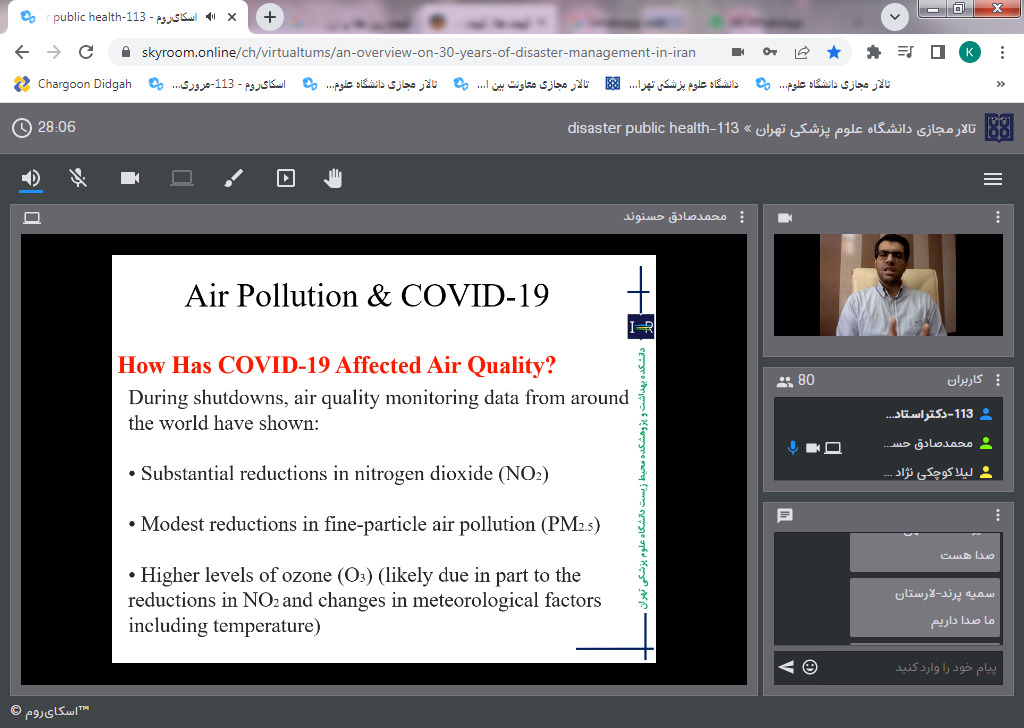Holding the 32nd dialogue meeting on the climate change and health
Holding the 32nd dialogue meeting on the climate change and health by the Center for Climate Change and Health Research, Environmental Research Institute of Tehran University of Medical Sciences (TUMS), entitled Climate Change and Air Quality
The 32nd dialogue meeting on the climate change and health was held virtually by the Center for Climate Change and Health Research, Environmental Research Institute of Tehran University of Medical Sciences (TUMS), and with the collaboration of the Department of Health in Emergencies & Disasters, School of Public Health, Tehran University of Medical Sciences (TUMS), on 20 June 2020. Dr. Mohammad Sadegh Hassanvand, Faculty Member of the School of Public Health, Tehran University of Medical Sciences, presented his lecture entitled Climate Change and Air Quality.

Dr. Hassanvand said that today, all over the world, climate change affects, directly and indirectly, air quality and consequently has human health disorders. About 90% of the world's population lives in areas affected by air pollution, and four hundred and seventy thousand children die in the first days after birth due to air pollution. Increasing concentrations of air pollutants are due to climate change, and on the other side, climate change leads to air pollution. In recent decades, chemical reactions of air pollutants have led to the destruction of the ozone layer and rising temperatures. Also, the concentration of pollutants has caused climate change on our planet.
Air pollution is classically divided into two categories: the first category is those that are the result of human routine activities, and the second class is hazardous pollutants that lead to cancer in people. In Iran, air pollution is the fifth-highest risk level, and this problem has increased the risk of heart diseases and respiratory problems at an early age. Death from diabetes, heart attack, and respiratory disorders are attributed to air pollution, so preventive measures that reduce this risk are really essential.
Suspended particulate pollutants account for 10% of all deaths. In Sistan and Baluchestan provinces, Particulate Matter (PM) is the third risk factor for health, which has a high rank of mortality attributed to air pollution. Followed by Sistan, other provinces including Khuzestan, Isfahan, Kermanshah, and Yazd have a significant percentage of deaths due to air pollution. Due to climate change in the western parts and western neighbors of Iran, dust and sand storms (DSS) have caused a sharp increase in air pollution. Air quality index PM2.5 and PM10 are used to measure the concentration of DSS.
In the DSS of April 2022 that exposed mane parts of Iran, the amount of PM2.5 in Tehran reached 1800 and in Khuzestan province reached over 4000 mg / m3, while in normal conditions this amount is 30 micrograms. This issue increases the risk of life-threatening diseases. As a result, preventive measures that reduce this risk are necessary. The problems of air pollution caused by PM prompted researchers and those involved, in cooperation with the National Academy of Medical Sciences, to prepare a comprehensive support document for the prevention of air pollution. In this document, to deal with the risk of DSS in Iran, some strategies have been developed. At the end of this meeting, attendants discussed the topic and asked their questions.
The powerpoint of this presentation is available at this link: https://s24.picofile.com/file/8451045284/Air_Poll_Climate_change_Dr_Hassanavnd_2022.pptx.html

Send to friends